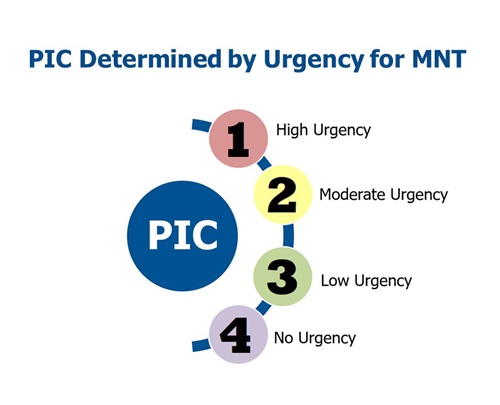The Prioritization Intervention Criteria (PIC) tool guides dietitians to see adult inpatients according to their urgency for medical nutrition therapy (MNT).
 The PIC tool:
The PIC tool:
- standardizes workload prioritization.
- informs workload distribution and resource planning.
-
Tool assumptions and requirements
A. Interprofessional approach to providing care
- Dietitians are a specialized resource providing medical nutrition therapy (MNT). They acquire their caseload by referral and are not expected to conduct in-depth screening of all patients.
- General monitoring of nutrition, hydration, and bowel function is best performed by point-of-care health care providers.
- Non-therapeutic care (e.g., obtaining food preferences) is not addressed by the PIC tool.
B. Nutrition Acuity Score (NAS)
- Once assessed, dietitians assign a NAS based on the patient’s nutrition problems using the NAS table (included in PIC tool download).
- A NAS is not assigned when:
- No nutrition problem identified (e.g., stable and not receiving maintenance MNT).
- Nutrition is not a focus of care (e.g., MNT refused, no further treatment options available).
- Assessment incomplete (e.g., insufficient information / unable to speak with the patient).
C. Monitoring / Termination of services
- Given the complexity of patient care, monitoring standards are not specified. Dietitians use clinical judgment to determine:
- Need for nutrition monitoring versus termination of services.
- Frequency of monitoring / monitoring intervals.
- NAS 4 patients generally should have services terminated and not be scheduled for monitoring.
- When dietitians determine monitoring is needed, it must be done as close to the predetermined timeline as possible (e.g., a NAS 3 patient at the monitoring deadline is a PIC 1 and should be seen prior to a new PIC 2 referral).
-
Instructions: Using the PIC tool
Step one: PIC assignment
Assign PIC values to all patients needing services that day regardless of the capacity you have to see them.
New referrals (assign a PIC value within 1 working day):
- Locate the referral reason in the table to determine the PIC value. If there are multiple reasons, assign the lowest PIC that applies (e.g., if a patient is on an unnecessary therapeutic diet (PIC 3) and has had low intakes for 6 days (PIC 1), assign PIC 1).
- When the referral reason is not provided, undertake minimal screening (less than 5 minutes) by consulting members of the health care team to determine the reason for the referral (a detailed review of the health record or consultation with the patient should NOT occur). If the reason for the referral is still not evident, do not assign a PIC value and alert the referral source that more information is required before the patient can be seen.
- If the referral is related to unskilled tasks (e.g., food preferences) do not assign a PIC value.
Patients on caseload:
- Use the monitoring deadline to determine the PIC value.
- When a date range is provided, the monitoring deadline is the last day of the range.
Step two: See patients according to their PIC value
The goal is to see PIC 1s that day; if this target is missed, they remain PIC 1s until seen.
- For PIC 1 monitoring, use the NAS to determine priorities (e.g., NAS 1s are generally seen before NAS 2s who are generally seen before NAS 3s).
- PIC 2, 3, 4 referrals related to intakes or malnutrition automatically become PIC 1 referrals as time passes as they deteriorate over time (e.g., 3 days without eating well becomes 4 days); some PIC 2, 3, or 4 referrals will not become PIC 1s over time and remain unseen until all PIC 1 monitoring and referrals are completed.
-
Definitions
Daily caseload:
Patients that should be seen that day. Compiled from referrals requiring MNT, patients requiring monitoring and referrals that need a PIC value assigned.
Termination of services:
Dietitians may terminate services for a variety of reasons including:
- Accepted nutrition plan is in place (e.g., education completed, NAS 4 patients).
- Goals are achieved.
- Goal of care has changed.
- There are no further treatment options.
- Patient refuses services.
-
Research
Validity & reliability testing of a nutritional acuity tool (2015-2017, unpublished)
Liz da Silva, Jan Chan, Treeva Elliott, Delara Saran, Kristina Vandop
Fraser Health Seed Grant Award ($5000)Content validity testing of a nutrition acuity scoring tool
Liz da Silva, Jan Chan, Treeva Elliott, Delara Saran, Kristina Vandop
Dietitians of Canada National Conference 2018 PosterReliability testing of a nutrition acuity tool
Jan Chan, Liz da Silva, Treeva Elliott, Delara Saran, Kristina Vandop
Dietitians of Canada National Conference 2018 PosterCreation of a priority tool to triage hospital patients and dispatch dietitian services
Alysone Martel, Liz da Silva, Lysa Wone
Dietitians of Canada National Conference 2018 PosterValidation of a Dietitian Priority Intervention Criteria Tool: A National Study (underway)
Alysone Martel, Liz da Silva, Christina Edmunds, Allison Hawkins, Flora Kwong, Janice Sorensen
Fraser Health Seed Grant Award ($5000) -
Contact us
Alysone Martel
alysone.martel@fraserhealth.ca
Download the adult inpatient PIC tool
The PIC tool includes both the PIC tables and the embedded Nutrition Acuity Score (NAS) tables. Refer to the instructions for how to use them in clinical practice.
The criteria are guidelines – some patient situations may not fit into the options listed. Always use clinical judgment to direct priority assignment; assess the relative risk for harm or deterioration and the relative potential for improvement.
